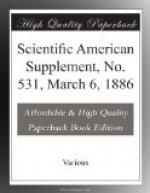Orthoclase becomes a clear glass filled with bubbles: at a lower temperature beryl behaves in the same way.
Topaz whitens to a milky glass—apparently decomposing, throwing out filmy threads of clear glass and bubbles of glass which break, liberating a gas (fluorine?) which, attacking the white-hot platinum, causes rings of color to appear round the specimen. I have now been using the apparatus for nearly a month, and in its earliest days it led me right in the diagnosis of a microscopical mineral, iolite, not before found in our Irish granite, I think. The unlooked-for characters of the mineral, coupled with the extreme minuteness of the crystals, led me previously astray, until my meldometer fixed its fusibility for me as far above the suspected bodies.
Carbon slips were at first used, as I was unaware of the capabilities of platinum.
A form of the apparatus adapted, at Prof. Fitzgerald’s suggestion, to fit into the lantern for projection on the screen has been made for me by Yeates. In this form the heated conductor passes both below and above the specimen, which is regarded from a horizontal direction.
J. JOLY.
Physical Laboratory, Trinity College, Dublin.
* * * * *
[AMERICAN ANNALS OF THE DEAF AND DUMB.]
TOUCH TRANSMISSION BY ELECTRICITY IN THE EDUCATION OF DEAF-MUTES.
Progress in electrical science is daily causing the world to open its eyes in wonder and the scientist to enlarge his hopes for yet greater achievements. The practical uses to which this subtile fluid, electricity, is being put are causing changes to be made in time-tested methods of doing things in domestic, scientific, and business circles, and the time has passed when startling propositions to accomplish this or that by the assistance of electricity are dismissed with incredulous smiles. This being the case, no surprise need follow the announcement of a device to facilitate the imparting of instruction to deaf children which calls into requisition some service from electricity.
The sense of touch is the direct medium contemplated, and it is intended to convey, with accuracy and rapidity, messages from the operator (the teacher) to the whole class simultaneously by electrical transmission.[1]
[Footnote 1: By the same means two deaf-mutes, miles apart, might converse with each other, and the greatest difficulty in the way of a deaf-mute becoming a telegraph operator, that of receiving messages, would be removed. The latter possibilities are incidentally mentioned merely as of scientific interest, and not because of their immediate practical value. The first mentioned use to which the device may be applied is the one considered by the writer as possibly of practical value, the consideration of which suggested the appliance to him.]
An alphabet is formed upon the palm of the left hand and the inner side of the fingers, as shown by the accompanying cut, which, to those becoming familiar with it, requires but a touch upon a certain point of the hand to indicate a certain letter of the alphabet.




